Ranipet
How to Reach
Air
The nearest International airport is Chennai Airport (105 km)
Train
Walajah Road Junction is the main railway junction situated near Ranipet (8 km)
Road
Ranipet is connected with major cities in the states of Tamil Nadu, Andhra Pradesh. The National Highways passing through Ranipet are NH 46 (Bangalore–Chennai road) and NH 4 from Ranipet to Chennai
I Square Taxi in Ranipet
Explore Ranipet with I Square Taxi
At I Square Taxi, we offer premium travel services including One-way Drop Taxi, Drop Taxi, and Round Trip options. Whether you need an Outstation Taxi, Intercity Taxi, or One-way Taxi, our service guarantees comfort. It is reliable and efficient for your travel.
Ranipet district was officially formed on November 28, 2019. It emerged after the division of Vellore district. The district serves as an important industrial and transport hub. The Chief Minister of Tamil Nadu officially declared this on August 15, 2019. This announcement included the creation of the Tirupattur district.
Ranipet is strategically connected via NH 46 (Bangalore-Chennai road) and NH 4. This provides easy access to key cities in both Tamil Nadu and Andhra Pradesh. With I Square Taxi, you can enjoy seamless travel to and from Ranipet, whether for business or leisure.
Tourism with I Square One Way Drop Taxi in Ranipet
Discover the Heritage and Industries of Ranipet with I Square Taxi
At I Square Taxi, we offer convenient travel options. You can choose from One-way Drop Taxi, Drop Taxi, and Round Trip services. These options cater to your specific needs. You might be traveling for a spiritual journey to a Pilgrim Center. Or you might be exploring the industrial hub of Ranipet. Our taxis are ideal for Outstation, Intercity, and One-way trips.
Pilgrim Centers
- Narasimmar Temple, Sholingar: With inscriptions dating back to the 14th and 17th centuries, this temple holds deep spiritual significance. It features a unique window through which devotees can catch a glimpse of Lord Narasimha giving darshan to Yoga Anjaneya. The temple is rooted in ancient traditions. Local legends say that Swamy Dhottachar prayed here after missing a Brahmotsavam at Kanchi.
- Rathnagiri Balamurugan Temple: Just 15 km from Vellore, this Murugan temple was built in the 14th century. It is a revered pilgrimage site perched on a small hill. Recent renovations have enhanced its charm, making it a popular destination for worshippers.
Industrial Hub
Ranipet is renowned as a significant industrial center in southern India. It is particularly known for its leather industries that produce finished leather goods like shoes and garments for export. The town also hosts small- and medium-scale industries. These industries are engaged in chemical, leather, and tool manufacturing. They form the economic backbone of the region.
With I Square Taxi, you can easily navigate the bustling industrial zones. You can also embark on a peaceful pilgrimage in and around Ranipet.


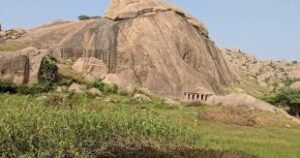
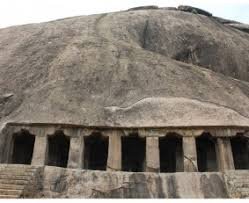
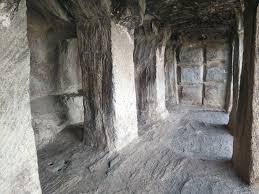
Thirupar Malai is being preserved by the Indian Archeological Department. It is located in the Vilapakkam village limits, a road from Arcot to Kannamangalam – 6 K.Ms southeast direction from Arcot.
A Pallava period cave temple is found in the southern part. The cave is built (engraved) with 6 fully sculptured pillars and two partially sculptured pillars.
The roof of the cave is filled with the paintings of Jain Thirthangarar. The stone bed Jains and the debris of age old brick constructions are found here. A beautiful Goddess Ambigai – Yakshini image is engraved here. This sculpture is proud to have sculptured in the era of king Thanthivarman. The King Raja Raja offered the village named Koorambadi. He gave it to the Jain monks as an offering. This is inscribed in the stone engravings. The protruding statues are beautifully seen sculptured here.



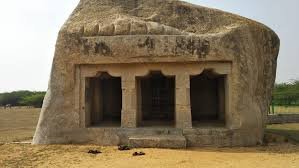

Mahendra Vishnukiraham rock carvings is one of the notable historic monument, located in Mahendravadi village of Arakkonam Taluk. This monument is preserved by the Archeological Survey of India . It is a very ancient rock temple of Tamilnadu. This rock carvings were built in the time of King Mahendravarman from 600-630 AD. The Grantha script inscription of the Mahendra Varman period ensures that Mahendra Vishnukiraham is named after King Mahendra Varman.
The carvings are done in a monolithic stone in an open space. This is a special feature of the monument. It holds a couple of full pillars and one half pillar. This construction attracts the visitors. Only Podhigai is carved in the pillars look very simple





In the 18th century, Sandha Sahib and Mohammed Ali fought for the title of Nawab. The Britishers intervened in the feud to favor Mohammed Ali.
The Britishers entered Arcot and driven away Sandha Sahib who is the enemy of Mohammed Ali. The army was headed by Robert Clive. This early success of Robert Clive led them spread the colonial rule all over India later. The building was constructed to celebrate the success of Robert Clive, hence it is called as Delhi Gate. The entrance of Delhi Gate is constructed with two storeys. One is the ground floor, and the other is the first floor. The ground floor was constructed to serve as place to secure armory. The first floor was designed to shelter the warriors. From there, they can view the enemies. They can also attack them using the fixed tankers on the first floor. With 4 feet high, the building was constructed with strong bricks and stucco is praiseworthy.




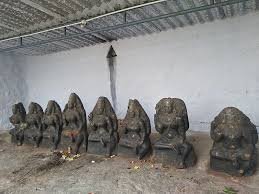
The statues of Seven Mothers are one among the monuments being preserved by the archeological department. The monument is located in the east of Perunkanchi, a way from Walajah to Sholinghur. The statues sculptured here belongs to the Pallava Kings of 8th century. These statues serve as the best example fiction of the Pallava’s art of sculpture.
The Seven mothers are:-
- Braami
- Maheswari
- Gowmari
- Vaishnavi
- Varahi
- Indirani
- Samundi
The statues of Vinyagar and Veerabathirar located here is even more noteworthy.





The inscriptions of this the village as Thiruvural and the name of the deity as Valeeswarar and Mummalai Iswarmudayar. An inscription of Rajendra Chola-I registers the gift of 32 cows for the abhisheka with milk. This gift was for the welfare of the king’s mother named Tribhuvana Maadeviyar. Another inscription informs that the bronzes of Umamaheswara and Vinayaga were worshipped in this temple.
The village used to be known as Tiruppamudhal and the deity Mahadevaraya Mummalai Easwaran Vikrama Chola (1123 A.D.) Rajendra-III. Inscriptions are found on the west and northern wall of the Karuvarai.





This Monument is located near a prominent road, opposite to Sholingar bus stand of Walajah Taluk. This monument with a width of 15 feet and length of 35 feet is called as Kanja Sahib cemetery. This cemetery is being preserved as one of the monuments by the Archaeological department. This is constructed with stucco and bricks. In 1781, the warriors of Tippu Sultan fought a battle against the British. The warriors fell in the field of Sholingar. It is believed that people dug a big pit. They buried the dead bodies of the soldiers in the pit. To verify this incident, it is engraved at the top of the yard.
The inscription goes as follows:-
This tomb is believed to mark the spot. It is where the bodies of the slain of the Mysore Army were interred. The Government of India conserves it to commemorate the Battle of Sholinghur 1781.





Kanchanagiri hills is a famous destination for the people of Ranipet. It is at a 1500 feet elevation. It houses a small Shiva temple and a Murugan temple.
The famous ‘bell rock’ in Kachanagiri is a sensation among the people of Ranipet.





The Ratnagiri Temple is dedicated to Lord Murugan. There are two forms of the deity in this temple. One form is Lord Thirukkolam, seen with his wives Valli and Devasena. The other form is Lord Gurukkolam. The idol of the main deity Bala Murugan was installed in a chariot which is made of granite. The garbhagriha is made of granite and is modeled according to the Chola architecture. The wall surrounding the shrine has small idols of Ganesha, Dakshinamurthy, Brahma, Durga, and Chandikeswarar. There are two temples for the Lord Vinayaka. One is on top of the hill. Another is at the bottom of the hill.
This temple was built in the 14th century by Arunagiri Nathar. It was renovated in the year 1980 by Bala Muruganadimai Swamy. The temple boasts a huge tower at the entrance. One of the special features of this temple is that the poojas are conducted in Tamil instead of common Sanskrit.




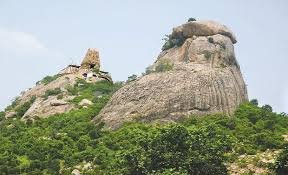
The name Kadigachalam came as the Lord gave darsan to the Saptharishi to a kadigai time and gave mukthi. He also gave darsan to Prahalatha by changing his figure of Terror and in the yoga stage. Lord Anjeneya who is in the yoga stage helped Indrathymna Maharaja in killing the Arakkan Nikumban and saved his country. It was held on Sunday and hence evey Sunday is an important one for Siriya Thiruvadi. People take a bath in the Chakkra Theertham of the small hill and worship the Lord. There is an inscription of 14th century in the Big Hill. Another inscription from the 17th century is in Small Hill. There is also an inscription in the Telugu Language. A small window is opposite to Lord Narasimhas Shrine at Big Hill. Through it, the Lord gives darsan to Yoga Anjeneya at Small Hill. Yoga Narasimhar is facing east and the Small Hill is at the eastern side of the Big Hill. Swamy Dhottachar used to worship Lord Varadaraja Perumal of Kanchi on the third day of Brahmotchavam every year. Once he was unable to visit kanchi and thus missed the Seva. The worried Dhottachar offered prayers to Lord Varadharajar sitting on the banks of Brahma Theertham at Sholinghur.





Raja Rani monument is situated in Ranipet town, on the banks of the Palar river. There are 2 towers built in the memory Raja Desingh and his beloved wife Rani Bai.
History reiterates that Raja Desingh refused to pay tax to British and hence British raided Arcot and killed Raja Desingh. In memory and love of her husband, Rani Bai committed Sati and died.
To honour the sacrifice of Rani Bai, Arcot Nawab Sadat-ul-lahkhan built this Monument on the opposite Bank on Palar. He named the town on the opposite bank Ranipet in memory of her sacrifice. Hence, the town received its name.